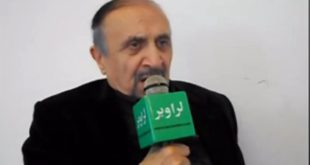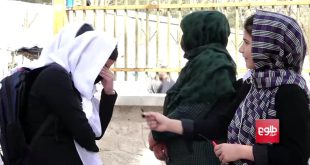When news of the assassination of Ahmad Shah Massoud reached the Western world, a resurgence of favorable press accounts of his military acumen and prowess were exhumed. Celebrated in song and story, Massoud was the modern incarnation of the classic resistance leader as immortalized by Hemingway’s ‘For Whom the Bell Tolls’ or Ken Follett’s ‘Lie Down with Lions,’ novels written in the classic guerrilla war genre. Deified by the French press as a cunning military tactician, the result of bold and daring raids on Soviet convoys launched from mountainous redoubts high above the Panjshir Valley, Massoud became the media-icon of the Afghan Resistance. But some question the political orientation of the respective correspondents as well as the veracity and objectivity of their interpretations. Were the reports factual or merely a celebrated ‘triumph of symbolism over substance’? For a number of Afghans and journalists however, the motive-force behind Massoud’s death is incontrovertibly linked to political machinations, espionage, treason, subversion and the enduring lure of retribution.
Eric S. Margolis, Toronto Sun foreign affairs editor and author of War at the Top of the World and The American Raj, Liberation or Domination, Resolving the Conflict between the West and the Muslim World had this to say about Massoud’s military record in a recent article for the Afghan Post, dated 10/23/01 and titled Spare us the Nation Building:
‘Massoud was adored by the Western media and was being groomed by Russia (his foreign backers) as the next leader of Afghanistan. Few outsiders knew that the dashing Massoud was regarded as a traitor by many Afghans for allying himself with the Soviets during the war and turning against his fellow Mujahideen.’
In a corroborating piece titled Ex-Soviet Commander Unveils Massoud’s Secret Pact, Weekly Mirror International, 5/23/01, correspondent Sami Yousefzai quotes Boris Gromov, former commanding general of the Soviet 40th Army Afghanistan: ‘The army of famed Jihadi Commander Ahmad Shah Massoud could convert the area into a graveyard for the Russian troops by only throwing rocks.’ The Soviet general went on to say that: ‘they immediately met with Massoud and signed an agreement with him in 1982 that ensured safe passage for the Russian Army through the precipitous and dangerous Salang Pass and Panjshir Valley and thus onward to the southern and eastern areas of Afghanistan and that Massoud sometimes staged sham skirmishes with the Russians to put off chances of suspicion about his activities among other Mujahideen groups.’ Massoud’s agreements with the Soviets remained in effect for the entire duration of the war. Many Afghans view Massoud’s consort with Russia as prolonging the decade-long war and as a precursor for the following civil unrest.
Arab Connection:
In the wake of the terrorist attacks on America, it has been a relatively easy matter for the media and those seeking political advantage to attribute acts of terrorism to the al-Qaeda network. Indeed, based on information obtained from Northern Alliance sources, one newspaper reported that ‘the death of Massoud was a gift to Taliban leader Mullah Omar from Osama bin Laden.’ But here we must be circumspect; the alleged role of suicidal Arabs in the death of Massoud raises more questions than answers. First, in hopes of eliciting US diplomatic and military support for their war against the Taliban, the Northern Alliance quickly learned to exploit the anti-Taliban atmosphere by posturing as victims of Osama bin Laden’s terrorist activities. Secondly, Sayed Ibrar, former Chief of the national carrier Ariana Afghan Airlines, and Dr. Wadir Safi, Minister of Civil Aviation, informed me during a 1997 interview while in Kandahar that: ‘Massoud had smuggled arms aboard the national carrier Ariana Afghan Airlines to Somalia warlord Muhammad Farah Aidid between 1992-1995, for which he received a ten-million dollar payment from Osama bin Laden.’ The payment was witnessed by well-respected resistance figure Brigadier Rahmatullah Safi.
Noteworthy as well, is the granting of Afghan citizenship to 837 members of al-Qaeda by Massoud and his titular boss Burhanuddin Rabbani during their administration. But for many of us, the most telling facts that militate against Arab participation in Massoud’s death are the passions known to motivate Arab suicide missions and for which Massoud had no known link:
(1) Israeli occupation of Gaza and West Bank, (2) unconditional US support of Israel, (3) US bases in Saudi Arabia, (4) the US bombing and sanctioning of Iraq, (5) and the ever-present anti-Islam bias incorporated in US foreign policy decisions.
An internal power struggle cannot be dismissed. Two-weeks prior to this death, Massoud entered into a power sharing arrangement with the Taliban. Muhammad Fahim, former Deputy Director of the Afghan KGB (KhAD) and Massoud’s successor, met with Russian Defense Minister Ivanov to voice his objections over the plan. Ivanov stated in unequivocal terms that: ‘Russia would not under any circumstances accept a power sharing agreement with the Taliban.’
In the view of many area specialists and Afghans, there is ample circumstantial and anecdotal evidence to conclude that a person or persons unrelated to al-Qaeda were involved in the assassination of Ahmad Shah Massoud. For example, recently it has been discovered that Abdul Rasul Sayyaf provided the stringent, required security clearances for the alleged-assassins to gain audience with and proximity to Massoud.
During June of 2007, Masood Khalili told the Indian press that just prior to the explosion that took the life of Ahmad Shah. He observed ‘a bright streak of light, the tell-tale exhaust signature of a missile in flight coming towards the building.’ As sole survivor, Khalili’s reconstruction of events lends credibility to the hypothesis that someone close to Massoud, someone who harbored visions of assuming a leading role in a successive leadership scenario engineered his assassination.
Bruce G. Richardson
Post Script Notes:
An ever-expanding plethora of incontestable evidence obtained from heretofore classified documents from 40th Soviet Army Afghanistan Archives, DRA, Western and other sources form what now exists to clearly demonstrate that the late Ahmad Shah Massoud and associates accommodations/collaborations with the USSR began as early as 1980. A partial, select listing follows:
Soviet Document: Fedotov, Alexandre: Professor of Asian and African History: Former member CPSU. Former advisor to President’s Leonid Kravchuk and Kuchma, Ukraine, currently: Chief Ukrainian Intelligence Service (SBU), Successor agency to the KGB. Personal Correspondence: ‘I know the name of the KGB officer who took Russian money to Massoud: Colonel Zakin Kadyrov,’ 2 November 1992.
Soviet Document: Gromov Boris V., Commanding General, 40th Army, Afghanistan, Limited Contingent, Moscow: Progress Press, 1994. pp. 188-197. Translation by Professor Ian Helfant: Department of Slavic Languages and Literature, Harvard University.
Soviet Document: Grigor’ev, S.E. The Pandzhsher from 1975-1990, Moscow: Saint Petersburg University Press, 1997. Translation by Professor Ian Helfant: Department of Slavic Languages and Literature, Harvard University, p.40.
Husseini, Sayed Noorulhaq, Mujahid, Journalist, Afghan Information and Documentation Centre (AIDC): An Interview with Bruce G. Richardson. ‘In 1985 in the Salang, I saw Massoud’s people riding on a tank with the Shuravi. They were laughing and joking together. Sometimes Massoud and the Shuravi would attack other Mujahideen’, Peshawar, 10 November, 1986.
Noorzoy, M. Siddieq Dr., Communications by Members of the Afghan Diaspora about Events in Afghanistan to US Leaders, the UN and World Leaders , September 21, 1979-October 7, 2013, pp. 1-25
Soviet Document: Main Intelligence Directorate (MID) of the General Headquarters USSR Armed Forces: title, Lion of the Panjsher, Article no. 18, (No. 882/83-3-S-77, Fond 80, Perechen 14, Document 77), translation by Elena Kretova, Information Services, Moscow.
Soviet Document: Liakhovskii, A.A., General, 40th Army, Plamya Afghana, Moscow, Iskon, 1999, pp. 485-486, translated for Cold War in History Project, Washington, DC, (CWIHP) by Gary Goldberg.
Mansur, Abdul Hafiz, The Panjsher: During the Time of the Jihad, translation by Sayed Asrarulhaq Husseini, Peshawar, 1991.
Margolis Eric S., American Raj, Resolving the Conflict between the West and the Muslim World, Key Porter Books, Ltd., 2008, p. 196.
Misdaq, Nabi Dr. Afghanistan, Political Frailty and Foreign Interference, Routledge, 2000, pp. 208-212.
Richardson Bruce G., Afghanistan: Ending the Reign of Soviet Terror: The Genesis of Massoudistan, Maverick Publications, Bend, Oregon, 1998, pp. 25-31, 69-71.
Richardson Bruce G., Afghanistan: A Search for Truth, Free Forum Publications, New York, Freeport, London, 2009, pp. 105-112.
Soviet Document: Shebarshin Leonid, (KGB official) The Hand of Moscow, Moscow Progress Press, 1992, pp. 177-214, translation by Professor Ian Helfant, Department of Slavic Languages and Literature, Harvard University.
Heinamaa, Anna, Maijai Leppanen, and Yuri Yurchenko, The Soldier’s Story, Soviet Veterans Remember the Afghan War, Berkeley University Press, 1994, pp. 113-122.
Judge-Quinn, Paul. Soviets to Embrace Afghan Foe, Christian Science Monitor, 19 October, 1988: pp. 1-8.
Soviet Document: Sudoplatov, Anatoly: Former KGB operative, author, and Professor of History, Moscow University. An Interview with Bruce G. Richardson, ‘Massoud was a back-channel into Afghanistan for us he also studied at the Frunze Military Academy under an assumed name with several of his top people. This was reported in Ogonyok by Artyom Borovik. About the dates, I’m not sure, sometime in 1983 or 1985’, Boston, 14 August 1995.
Tanai, Shah Nawaz: An interview with Bruce G. Richardson, translation by Sayed Noorulhaq Husseini, Rawalpindi, Pakistan, 12 November, 1997.
Soviet Document: Varennikov, Valentin, General, 40th Army, Secret Report to Soviet Defense Minister, General Dmitri T. Yazov, August 1988. Excerpt: General Varennikov: ‘In our view, the adoption of the proposal of the President about involving the 40th Army in battles with A. Shah could place our troops in an extremely serious situation during the second stage of their withdrawal from Afghanistan. A. Shah has categorically prohibited his formations from waging combat operations against Soviet troops. At the same time he continues to speak out as an irreconcilable opponent of the government authority, although he refrains from using force if government troops do not shoot (which is in accord with the policy of national reconciliation.) In the future Ahmad Shah might grow into an important political figure with whom the Soviet Union, in all probability, will have to cooperate and it would be to our advantage to keep him as an ally and not an enemy, translated by Gary Goldberg for Cold War in History Project (CWIHP), Washington, D.C., Bulletin, Issue, 14/15, pp. 263-264.
 لراوبر ویب پاڼه لراوبر يو افغان – تازه خبرونه
لراوبر ویب پاڼه لراوبر يو افغان – تازه خبرونه


